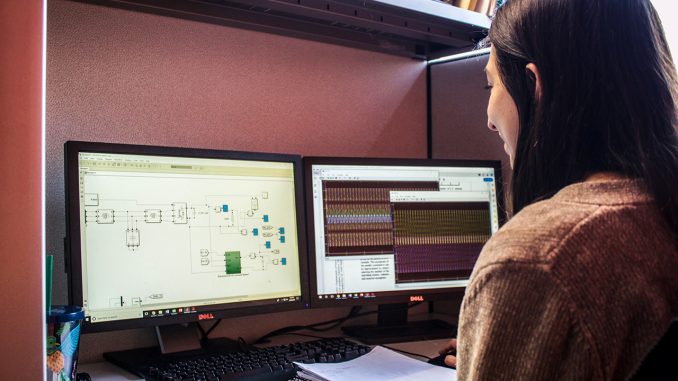
Inspired by the practicality of transportation research and the impact it can have on a city’s sustainability, Kaitlyn Sitch enrolled in Temple University’s electrical engineering Ph.D. program.
Her adviser, electrical and computer engineering professor Liang Du, then introduced her to the idea of microgrids and how they can assist hybrid-electric public transportation.
“Sometimes when you’re doing research it could be something that will never see the light of day, but with this, it is something that other cities are implementing,” Sitch said. “A microgrid system, even though it’s not necessarily implemented in Philadelphia, maybe it will be somewhere else, or something similar.”
Microgrids work with local energy and can generate power on their own. Sitch has researched them since November and will present her findings at the Institute of Electrical and Electronics Engineers Transportation Electrification Conference and Expo in Michigan from June 19-21. The event aims to help the transportation industry transition from standard vehicles to more sustainable options.
Other cities that are moving toward hybrid-electric bus fleets that charge the buses in the time it takes passengers to board and depart, Sitch said. But this creates peaks in the energy because the buses have limited charging time.
Sitch is researching how to alleviate that peak to make power more constant over a long period of time, so transportation companies can better predict how much energy they will need, she said.
A microgrid is similar to a converter, meaning it controls the battery that charges a bus and helps “convert” between different types of power, she said.
For her research, Sitch is using SEPTA’s bus routes to determine how long each stop is and how much time each bus would have to charge while people are getting on and off the bus.
SEPTA is working on an Energy Action Plan that entails making 90 percent of its buses hybrid-electric by 2021. Using the bus data from SEPTA is the practical aspect of Sitch’s research, but the rest is mostly theoretical, she said.
“It’s not something that would be implemented with that right now, but maybe eventually this might be something that’s feasible,” Sitch added. “Now, I think some utility companies are looking at working with microgrids, too, so it would in the future, just maybe not with this Energy Action Plan that they’re doing right now.”
Last summer, SEPTA received a $1.5 million Federal Transit Administration grant to purchase 10 new electric buses. The buses are part of the company’s pilot program to evaluate electrical technology’s performance in the city.
Second-year electrical engineering Ph.D. student Dongsen Sun is assisting Sitch in her research. Sun has previously worked with microgrids and has experience with power electronics, she said.
Sun helps Sitch set up the simulation module and assists with developing the control screen if problems arise.
“Sometimes, we will have a discussion on the simulation itself and what’s the issue we have or what’s the next step of the project,” Sun added.
Cost and Philadelphia’s current infrastructure are concerns for converting the city’s bus services into a hybrid-electric or fully electric bus fleet, Du said.
“Everyone wants electrical vehicles, but our current infrastructure can’t support it because it’s too old,” Du said. “We’re already one of the worst major cities in the states where we have energy burden, which means on average the low-income [residents] have to take…their income to pay for energy and upgrading the construction they’re not able to pay for it.”
Philadelphians’ median household income is $39,759, and 58 percent of the population earns less than $50,000, putting 25.7 percent of the population below the poverty line.
Du hopes Sitch’s research can help Philadelphia begin to move toward a more electric fleet.
“I hope that this research can land a viable plan in terms of the technology and in terms of the economic part…that can support this smooth transit from our current complications into a more electrified [vehicles],” he added.
Sitch anticipates working on the research for at least a year and plans to use it to write her thesis.
She hopes her work can help inform public transportation plans, she added.
“[I hope] this research would help to make the buses and everything even more sustainable,” she said. “At that point, there would be less emissions. I guess the hope would be it would make everything more sustainable.”



Be the first to comment